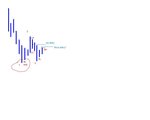frugi
1
- Messages
- 1,843
- Likes
- 133
No worries and thanks pogle. 🙂
The 15:34 bar was a potential #3 point but the 15:42 made a lower low, thus negating its potential without a buy order having been triggered first (since the high of the 15:34 bar was not taken out). I take entries from the break of a potential #3 bar's hi/lo, not that of any bars that follow. A potential #3 point is negated if its low is taken out by a subsequent bar. Actually the 15:42 bar negated the whole 123 long setup as it made a LL than the first #1 14:58 bar. A new #1 means start looking for #2 and #3 again, obviously.
It did break the high of the 15:38 bar but there was no entry triggered as the 15:38 bar was not a potential #3 point as it had a HL than the previous bar which was the potential #3 point.
Confused? 😆 I am.
I leave the trailing stop where it is if a bar makes a LL than the previous bar (for longs). So when the 16:50 bar closed I move it to 491, below the previous bar low. The 16:54 and 16:58 bars made LLs without taking out 491 (miraculously) so it stayed where it was.
The 15:34 bar was a potential #3 point but the 15:42 made a lower low, thus negating its potential without a buy order having been triggered first (since the high of the 15:34 bar was not taken out). I take entries from the break of a potential #3 bar's hi/lo, not that of any bars that follow. A potential #3 point is negated if its low is taken out by a subsequent bar. Actually the 15:42 bar negated the whole 123 long setup as it made a LL than the first #1 14:58 bar. A new #1 means start looking for #2 and #3 again, obviously.
(I'm assuming here that the 15:42 bar broke the H of the 15:38 bar triggering an entry before retreating below the 15:34 bar).
It did break the high of the 15:38 bar but there was no entry triggered as the 15:38 bar was not a potential #3 point as it had a HL than the previous bar which was the potential #3 point.
Confused? 😆 I am.
I leave the trailing stop where it is if a bar makes a LL than the previous bar (for longs). So when the 16:50 bar closed I move it to 491, below the previous bar low. The 16:54 and 16:58 bars made LLs without taking out 491 (miraculously) so it stayed where it was.


